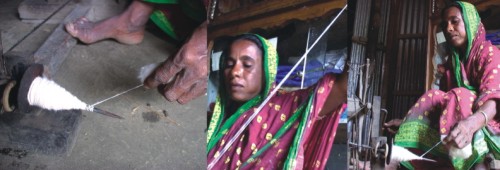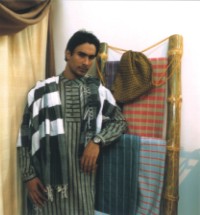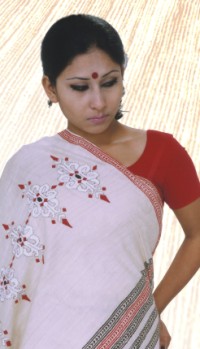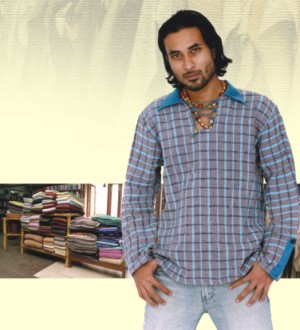| |
 A
Tradition That's Trendy A
Tradition That's Trendy
Shamim Ahsan and Kajalie Shehreen Islam
What is known as khadi
today was produced and used for years by the middle
and working classes of the sub-continent in the 19th
century, especially during the Swadeshi movement. The
turning point, however, came in the 1920s with Mahatma
Gandhi's Non-Co-operation Movement. One provision of
this non-violent movement was to produce and use only
local goods, including homemade clothing, i.e., khadi.
Gandhi gave the art of khadi a special status
through this movement, writes Bijon Guha in his article,
"Khadi Ebong Amar Jibon" ("Khadi
and My Life” in a brochure for Kay Kraft's khadi Utsab).
After the two movements, however, the popularity of
khadi cloth came down.
Khadi is, however, unique. Its basic definition,
say experts, is that it is hand spun and hand woven.
"The difference between khadi and handloom
is apparent in the texture," says Ruby Ghuznavi
of Arannya and President of National Craft Council.
"Handloom is smooth while khadi is uneven."
Real Khadi can only be made from cotton yarn,
says Ghuznavi. Muslin was a kind of khadi when
the yarn was very, very fine, she says, but you can't
get that kind of finesse anymore. What we have now is
the kind Gandhiji wore -- thick khadi. "Real
khadi has to be uneven, unless it's fine khadi,"
says Ghuznavi.
Many
khadi wholesalers and retailers complain that
dyed khadi will always have blotches of colour,
or uneven shades within the same thaan. But
Ghuznavi says that it is only when the yarn is dyed
before weaving and not the whole thaan that
the colour comes out in uneven shades. "It doesn't
have to be this way", she says. " It wasn't
this way when Guha Babu was alive."
In
Bangladesh, no one can speak of khadi without
referring to Shoilendranath Guha, probably the biggest
contributor to the art of khadi and natural dye.
"I
ordered 12,000 metres of khadi thaan from Guha
Babu," recalls Ruby Ghuznavi, "and he fulfilled
the order perfectly. I wouldn't dare do it today because
I know it won't be done right. They cannot do it."

Today, the khadi tradition
is being carried on by his sons, namely, Bijon and Arun
Guha. Spun by weavers in Chandina, Guha's descendants
seem to be the only ones producing khadi in Bangladesh
supplying various outlets and organisations with the
material.
"Shoilen
Guha wanted the Bangladeshi flag to be made of khaddar,"
reminisces Shahid H. Shamim, Director of prabartana.
"He did make some, but if the government took steps
for all our flags to be made of khadi, it would
be something."
Shoilendranath Guha believed
that a big industrial revolution could be brought about
with khadi. Khadi production is human-resource based,
says Shamim. Its popularity and thus increased production
would mean the employment of thousands of weavers.
 Sadly,
however, weavers are changing professions, moving on
to better-paying jobs, and in the process, we are losing
the art of weaving. Sadly,
however, weavers are changing professions, moving on
to better-paying jobs, and in the process, we are losing
the art of weaving.
Throughout the second half
of the 20th century, use of khadi fell consistently.
Towards the early nineties, however, khadi made a sudden
and strong comeback, thanks to a number of fashion houses
like Aarong, Kay Kraft, Prabartana, Arannya and many
others who have successfully synchronised technology
with heritage by complementing the local weaving industry
with modern machinery.
The survival of khadi and subsequent
rise in its popularity has been significant both in
terms of heritage and economy. Khadi has been very much
a part of our life and lifestyle, and in its hundreds
of years of expansion it holds the history of a people's
evolution, their struggle, their joys and tears.
On the economic front, khadi's growing
acceptance since the early nineties has at least kept
our local weaving industry going in a market that has
been made free unscrupulously and consequently flooded
with Indian goods. In the last ten years or so, these
fashion houses have succeeded not only in bringing khadi
back into the mainstream -- though in a very small way
-- but, more importantly, in exploiting the originality
of khadi by turning out khadi clothes into fashion wear.
 Kay
Kraft's Khadi Utsab Kay
Kraft's Khadi Utsab
Kay Kraft is one of the leading houses
that have contributed to this rescue act of khadi. Since
its early days, Kay Kraft has taken it upon itself to
provide khadi a much-needed platform and to help it
blossom to its full potential. Those associated with
Kay Kraft have scoured the country discovering, talking
to and motivating the ever shrinking, endangered community
who have been working with khadi for generations. At
one point, Khalid Mahmud Khan, Director of Kay Kraft,
met Shoilendranath Guha -- an extremely respected name
in the khadi industry -- in Chandina, Comilla.
"The meeting was crucial for Kay
Kraft," says Khan. "We had heard a lot about
this man -- his struggle, sincerity and devotion to
the khadi industry. As we met we talked about khadi,
its problems and strengths." When taking leave,
Khan invited Guha to his home and could hardly believe
his luck when Guha visited him in just seven days. "He
requested us to work with khadi and though we had already
begun, his request made a great impression on our minds,"
says Khan. "We felt extremely inspired and motivated
and embarked upon our goal with renewed energy,"
he reminisces. Guha's request and Kay Kraft's efforts
did not go in vain.
It wasn't easy, though. One of their
first challenges was to prove wrong the popular notion
that khadi was only a poor man's garment. The somewhat
rough texture, uneven finishing and, above all, the
dull designs made khadi rather unattractive and failed
to appeal to the fashion-conscious youth.
"Our
first job at hand was to show that, if creatively done,
khadi products can also be appealing and of high
standards. When we started, punjabis and fotuas
were still village people's get-up; the urban middle
class were not very fond of it. Our first venture with
khadi was to use it in punjabis and
fotuas and our products were received extremely
well by customers. While we were attentive to design,
we also experimented on a kind of amalgamation, sometimes
by combining silk with khadi and sometimes mill-produced
fibre. The initial success boosted our confidence and
we are now doing a lot more experimentation to develop
new designs," Khan relates.
Khadi,
because it is hand spun and hand woven, has its own
distinct quality. "While developing new designs
we have always endeavoured to keep khadi's characteristics
intact," says Khan. "Even when we mix silk
and artificial fibre with khadi, we do it in
a way so that the end product does not lose the khadi
touch, rather it brings out its effects," Khan
says, explaining the main feature of their design.
Khan also believes that khadi is more
expressive and designers have a lot more to do with
the material. "The coarse texture of khadi provides
a wider scope to experiment with design. Its distinct
nature gives the space to use your creativity more than
fine-textured artificial fibre," says Khan. "Again,
mixing silk or other varieties with khadi gives one
the opportunity to play with the weaving designs like
putting the different fibres in different combinations,
changing their frequency and density here and there,"
Khan explains, referring to textile designing.
 Khadi
is our heritage, connected with our soil and lifestyle
and it has lived on for hundreds of years across generations.
Fortunately, many fashion houses felt they must try
to save our heritage at all costs. "When we established
Kay Kraft we wanted to create a niche in fashion wear
by developing our own style," says Khan. "You
cannot claim originality borrowing others' things and
depending on foreign ideas, so khadi was our
automatic choice. From a business point of view khadi
was also the preferred choice. If people get trendy,
good quality khadi products they will certainly
prefer them to foreign ones and won't even mind paying
a little more. So khadi serves both purposes
-- of satisfying the demand of fashion as well as making
people proud of wearing local products. And this is
where lies Khadi's potential," Khan says. Khadi
is our heritage, connected with our soil and lifestyle
and it has lived on for hundreds of years across generations.
Fortunately, many fashion houses felt they must try
to save our heritage at all costs. "When we established
Kay Kraft we wanted to create a niche in fashion wear
by developing our own style," says Khan. "You
cannot claim originality borrowing others' things and
depending on foreign ideas, so khadi was our
automatic choice. From a business point of view khadi
was also the preferred choice. If people get trendy,
good quality khadi products they will certainly
prefer them to foreign ones and won't even mind paying
a little more. So khadi serves both purposes
-- of satisfying the demand of fashion as well as making
people proud of wearing local products. And this is
where lies Khadi's potential," Khan says.
Over the last decade, khadi goods have
come a long way both in terms of quality and design.
What has made various fashion houses like Kay Kraft
or Prabartana or Arannya succeed is their ability to
adapt their khadi products to contemporary tastes. "We
have always been very sensitive to changing trends and
experimented with new ideas in our products," says
Khan.
One particular change has been the diversification
of products. For a long time the use of khadi was confined
to only a few items like punjabis, kurtas and
kotis, so Kay Kraft recently began experimenting
with other products as well. The Khadi Utsab, held from
January 15 to 18 of this year arranged by Kay Kraft
was in fact the result of their experimentation with
specially developed products with some very creative
designs. "We had a whole variety of khadi products
including sarees and shalwar kameezes where
we tried to explore new ideas in terms of design,"
explains Khan. The four-day long festival drew a large
number of visitors and Khan adds that they spoke very
highly of the products.
***
THE problem with khadi isn't the market,"
claims Ruby Ghuznavi. "There is a big enough market
for pure khadi compared to the production. The problem
is that production of genuine khadi is low and definitely
not enough for export."
Much of what is sold as khadi in our
country today is fake, says Shahid H. Shamim. That is,
it is not hand spun and hand woven but produced in machines
and mills. "Many of the punjabis and other khadi
cloth sold are hardly khadi," he says.
"Most people don't buy khadi because
it's khadi," says Ghuznavi. "They buy it because
they like it." So why not sell khadi as khadi and
handloom as handloom? Blending is fine, agree both Ghuznavi
and Shamim, as long as it remains pure khadi, that is,
as long as it is, in fact, hand-spun and hand-woven.
Among silk, however, says Ghuznavi, only endy
silk is hand-spun from caster leaves and so combination
with any other variety of silk is not really khadi.
Arannya
itself mainly produces curtains made of khaddar
for export, as well as accessories such as scarves along
with Western wear. The market is good enough, Ghuznavi
believes, but to compete in the foreign market, we cannot
just accept things like "the colour will be uneven
and this will be like this" and so on.

"At Prabartana we are making souvenir
scarves with yarn made from jhum cotton from
the hill tracts," says Shamim. "We are also
experimenting with fine khadi which is not available
here and which we will be exporting to countries like
Japan. It is still at the development stage, however,"
says Shamim.
"Indigenous societies in our country
also make a green cotton, that is, there are no chemicals
in it," adds Shamim. "If we could market this
abroad, it could also be quite profitable."
Sarwat Abed, Director of Aarong, puts
emphasis on the diversification of khadi goods. "If
we cannot multiply khadi products and create a bigger
market all our sincere efforts to support and patronise
the local looms will fail," she says. She however
admits that Aarong has not worked extensively with khadi
in recent times and at the moment does not have a huge
collection. "But we have our plans. At the moment
we are doing a lot of research work and our designers
are working to develop new khadi products and designs,"
Abed assures. She says that Aarong is also working on
making household products along with the traditional
khadi apparel such as punjabis, shawls, fotuas,
tops, etc.
What we need more than a market for
khadi is to create awareness, inform people and promote
genuine khadi, says Ruby Ghuznavi. And we need to increase
production. If Guha Babu was alive today, she says,
he would have expanded the production to five times
its present size, involving more spinners and weavers
and building a huge market.
Every
patron of khadi will quote the Late Shoilendranath
Guha as saying that if we all used one khaddar payjama-punjabi
a year, it would do wonders -- for ourselves, the tradition
and the country. In Shoilen Guha's own words, "Apnara
ei khaddar kapor babohar kore khaddar shilpoke bachiye
rakhun." Use khaddar cloth and keep the art
alive.
|
|

 A
Tradition That's Trendy
A
Tradition That's Trendy
 Sadly,
however, weavers are changing professions, moving on
to better-paying jobs, and in the process, we are losing
the art of weaving.
Sadly,
however, weavers are changing professions, moving on
to better-paying jobs, and in the process, we are losing
the art of weaving. Kay
Kraft's Khadi Utsab
Kay
Kraft's Khadi Utsab Khadi
is our heritage, connected with our soil and lifestyle
and it has lived on for hundreds of years across generations.
Fortunately, many fashion houses felt they must try
to save our heritage at all costs. "When we established
Kay Kraft we wanted to create a niche in fashion wear
by developing our own style," says Khan. "You
cannot claim originality borrowing others' things and
depending on foreign ideas, so khadi was our
automatic choice. From a business point of view khadi
was also the preferred choice. If people get trendy,
good quality khadi products they will certainly
prefer them to foreign ones and won't even mind paying
a little more. So khadi serves both purposes
-- of satisfying the demand of fashion as well as making
people proud of wearing local products. And this is
where lies Khadi's potential," Khan says.
Khadi
is our heritage, connected with our soil and lifestyle
and it has lived on for hundreds of years across generations.
Fortunately, many fashion houses felt they must try
to save our heritage at all costs. "When we established
Kay Kraft we wanted to create a niche in fashion wear
by developing our own style," says Khan. "You
cannot claim originality borrowing others' things and
depending on foreign ideas, so khadi was our
automatic choice. From a business point of view khadi
was also the preferred choice. If people get trendy,
good quality khadi products they will certainly
prefer them to foreign ones and won't even mind paying
a little more. So khadi serves both purposes
-- of satisfying the demand of fashion as well as making
people proud of wearing local products. And this is
where lies Khadi's potential," Khan says.